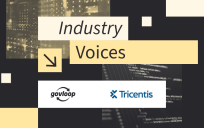If you could wave a magic wand and transform one thing, what would it be? Some of us might change our Ford into a Ferrari or our cold cuts into caviar. But how many of us would think to transform government?
At GovLoop’s recent “Government Innovators Virtual Summit: Solving Your Agency’s Biggest Challenges,” attendees who tuned in to the “Purpose Driven Government” session got an idea of what that transformation might look like. An informative and forward-thinking presentation by Chris Atkins, Vice President for Digital Government Transformation at SAP, walked through the ways in which modernizing both technology and philosophy can lead to a truly citizen-centric government that’s able to keep up with the demands of today’s changing world.
Atkins began with a simple proposition: that “government should solve problems with evidence.” From this starting point, he began a thought-provoking discussion of how to accomplish that goal.
His first point was that government has to become intelligent.
“It must leverage data and new technologies to build intelligent scenarios across its enterprise,” Atkins said. This starts with getting government the capabilities it needs to make evidence-based, data-driven policy.
With that in mind, one of the first areas that needs to be addressed is the role of data in enabling government’s mission.
“Data is often siloed,” Atkins said. Step one is making sure that the huge amounts of information that governments collect are available to those who can make the best use of it. After that, governments must consider how to leverage technology to interpret the data and gain meaningful insight.
When seeking to turn data into actionable information, it’s important to remember to put the citizen at the center of everything. As Atkins put it, there should be a citizen horizontal that sits across all government verticals.
“Citizen expectations should not just be met, they should be exceeded,’ he said, noting that rising demand is placed on government by citizens accustomed to the private sector experience.
Atkins had several compelling case studies to share regarding the transformative power of modern, data-savvy government, backed by flexible solutions and support.
In Indiana, data-driven policy design meant in-depth data analysis to identify and combat factors contributing to an infant mortality rate that refused to go down despite years of well-intentioned but less-informed efforts.
Another interesting example was from Queensland, Australia, where the government was able to analyze information collected on the behavior of uncooperative taxpayers and implement data-based policy changes that increased the efficiency of collection efforts.
When it comes to getting government the capabilities it needs to make evidence-based, data-driven policy, Atkins, aware of the ever-present budget bogeyman, suggests starting with a single use case for an easy win to demonstrate value and feasibility. He also points out that innovation often saves money, as governments spend millions and even billions of dollars every year maintaining legacy systems that often deliver sub-standard outcomes for citizens.
“Government has a timeless mission,” Atkins said. In his view, a commitment to intelligent modernization can help government reach a citizen-centric focus that will allow it to provide, protect and prosper.
Want more content like this? Get ahead of the game and pre-register for more free government virtual summits.






Leave a Reply
You must be logged in to post a comment.